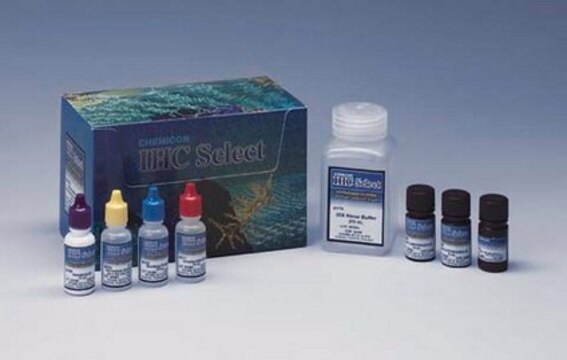11718096001
Roche
DAB Substrate
dark brown, /black precipitate; Visually evaluated
Sinónimos:
3,3′-diaminobenzidine tetrahydrochloride, DAB
About This Item
Productos recomendados
manufacturer/tradename
Roche
Quality Level
color
dark brown, /black precipitate; Visually evaluated
storage temp.
−20°C
General description
3, 3′ diaminobenzidine tetrahydrochloride (DAB) is a carcinogen that should be used safely. It is one of the major sensitive substrates for HRP (horseradish peroxidase). DAB is brown or amber in color and becomes insoluble and precipitates over the antigen-antibody site due to the presence of hydrogen peroxide and peroxidase.
Application
- DAB Substrate is a color sustrate for peroxidases and is used in a variety of applications:Immunohistocytochemistry
- In situ hybridization
- Western blot
- Dot blot
Packaging
Preparation Note
- Determine the volume of substrate required for the development of peroxidase.
- Remove the DAB/metal concentrate (10x) from -15 to -25 °C storage.
Note: Do not bring to 15 to 25 °C. - Dilute the DAB/metal concentrate (10x) with the peroxide buffer to a 1x working solution. For example, if 5 ml of substrate are required, dilute 500 μl of the DAB/metal concentrate (10x) with 4.5 ml of the Peroxide buffer.
- Mix well.
- Add the 1x working solution to the tissue or blot until desired substrate development.
Note: The 1x solution is stable over many hours.
For best results, store the working solution at 2 to 8 °C when not using.
Storage conditions (working solution): 2 to 8 °C
For best results, store the working solution at 2 to 8 °C when not using.
Other Notes
Solo componentes del kit
- DAB/metal concentrate, 25 ml 10x concentrated
- Peroxide Buffer, 250 ml
signalword
Danger
Hazard Classifications
Acute Tox. 3 Dermal - Acute Tox. 3 Inhalation - Acute Tox. 4 - Aquatic Chronic 2 - Carc. 1A - Carc. 1B - Flam. Liq. 2 Oral - Repr. 1B - Skin Sens. 1 Inhalation - STOT RE 2 - STOT SE 1
Storage Class
3 - Flammable liquids
wgk_germany
WGK 3
Certificados de análisis (COA)
Busque Certificados de análisis (COA) introduciendo el número de lote del producto. Los números de lote se encuentran en la etiqueta del producto después de las palabras «Lot» o «Batch»
¿Ya tiene este producto?
Encuentre la documentación para los productos que ha comprado recientemente en la Biblioteca de documentos.
Los clientes también vieron
Nuestro equipo de científicos tiene experiencia en todas las áreas de investigación: Ciencias de la vida, Ciencia de los materiales, Síntesis química, Cromatografía, Analítica y muchas otras.
Póngase en contacto con el Servicio técnico









